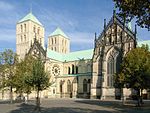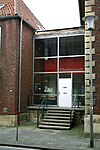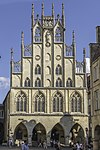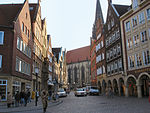Münster

Münster ( MUUN-stər, German: [ˈmʏnstɐ] (listen); Low German: Mönster) is an independent city (Kreisfreie Stadt) in North Rhine-Westphalia, Germany. It is in the northern part of the state and is considered to be the cultural centre of the Westphalia region. It is also a state district capital. Münster was the location of the Anabaptist rebellion during the Protestant Reformation and the site of the signing of the Treaty of Westphalia ending the Thirty Years' War in 1648. Today it is known as the bicycle capital of Germany. Münster gained the status of a Großstadt (major city) with more than 100,000 inhabitants in 1915. As of 2014, there are 300,000 people living in the city, with about 61,500 students, only some of whom are recorded in the official population statistics as having their primary residence in Münster. Münster is a part of the international Euregio region with more than 1,000,000 inhabitants (Enschede, Hengelo, Gronau, Osnabrück).
Excerpt from the Wikipedia article Münster (License: CC BY-SA 3.0, Authors, Images).Münster
Domplatz, Münster Altstadt (Münster-Mitte)
Geographical coordinates (GPS) Address Nearby Places Show on map
Geographical coordinates (GPS)
| Latitude | Longitude |
|---|---|
| N 51.9625 ° | E 7.6255555555556 ° |
Address
Ökologischer Bauernmarkt
Domplatz
48143 Münster, Altstadt (Münster-Mitte)
North Rhine-Westphalia, Germany
Open on Google Maps










